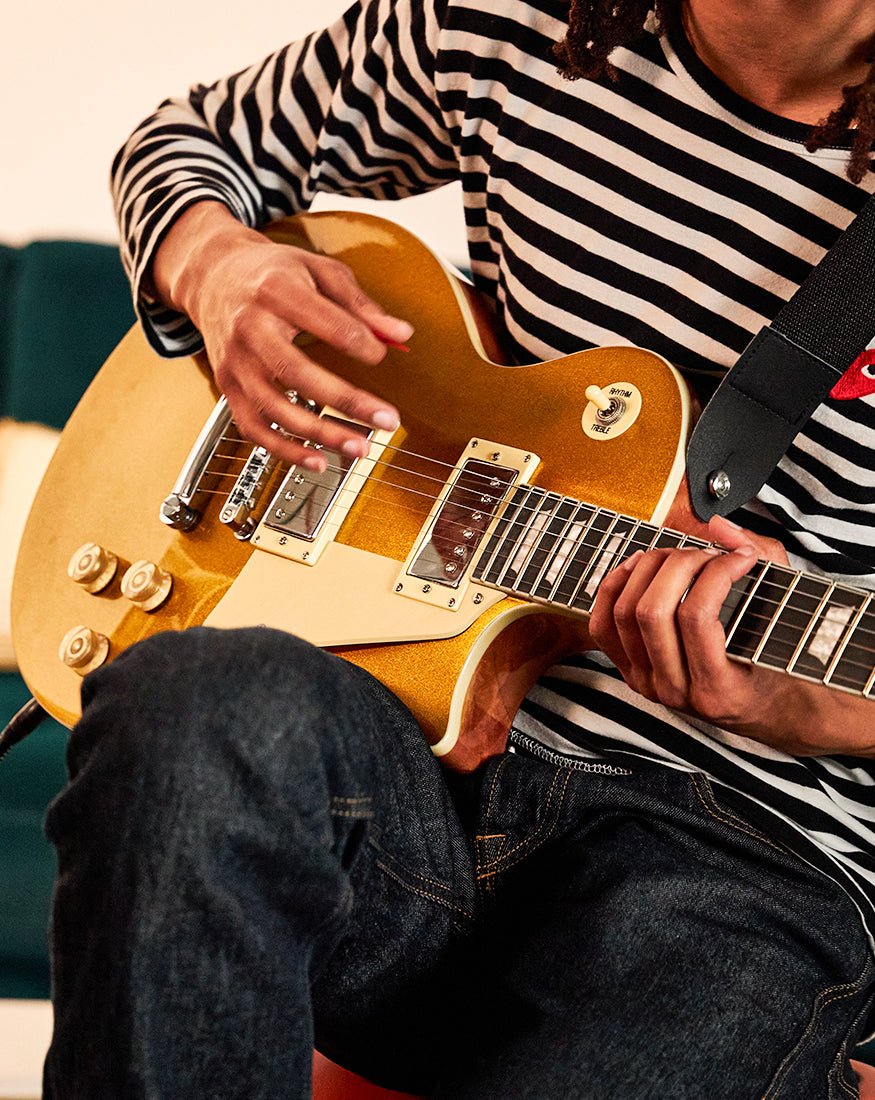Ready to get your hands on a beginner electric guitar, but not sure where to start? You’ve come to the right place.
When it comes to choosing the best electric guitar for beginners, there are a lot of options available and choosing the right one can be confusing and overwhelming.
There are so many different options available – from the body shape to the pickups and everything in between. So, how do you make sure you’re choosing the right one?
We’ve got you covered.
In this comprehensive guide, we’ll go through the five most important factors to consider to make sure you get the best beginner electric guitar for your unique needs.
Let’s get started!
1. Cost
First thing’s first, establish how much you want to pay for your new electric guitar.
When buying for beginners – especially younger players – you may not want to spend too much without knowing whether they’ll stick with the guitar. That’s totally fair. Luckily, there are plenty of affordable electric guitars for beginners on the market.
LyxPro is proud to offer a wide range of electric guitars under $300, so you can find the perfect starter instrument without breaking the bank.
Remember, your new electric guitar will need an amplifier and cable, so be sure to factor that into your budget as well. It may be worth purchasing a complete beginner electric guitar kit, so you can get your amp and accessories all in one go.
2. Size
Now that you’ve established a budget, it’s time to talk size.
Make sure your beginner electric guitar fits the player. Your 7-year-old nephew might not be able to handle the heft and size of a full-sized electric guitar, but a ¾-size, or even ¼-size beginner guitar might be the perfect fit for their little hands.
Full-sized beginner electric guitars vary considerably in size and weight, as well, and these are factors that should be considered when purchasing.
3. Material
It’s time to get into the finer details.
Beginner electric guitars come in many different materials, AKA: tonewoods, because of how they can affect sound quality. The resonance from the wood determines how long the strings vibrate, and the shape of their motion. It also allows the pickup itself to move, making it a super important factor in the overall tone of the guitar.
Some of the most common woods used are mahogany, maple, and rosewood.
Mahogany
Mahogany is a very strong, dense wood, generally used in all parts of the guitar, except the fretboards and bridges, which require harder wood.
Because mahogany is not very hard, it emphasizes the midrange and bass frequencies, producing a mellower guitar tone. It’s got a very warm tone with great sustain and is great for blues, rock, and even metal.
Similar to: Koa and korina.Maple
Maple is a hard, dense wood most commonly used in guitar necks, fingerboards, and bodies. It has a very bright overall tone, and its hardness brings out the trebles in a guitar’s sound.
The bright sound makes for a good “attack” (fast note sounds for clean, funky playing), and it’s great for producing rock, blues, and even country music.
Similar to: Pine, poplar, paulownia, and ash.Rosewood
Rosewood is the most common wood used for electric guitar fretboards. It is very dense and hard and produces a “tight” articulation of notes with a smooth feel.
While rosewood can be used in beginner electric guitar bodies as well as necks, it is not common, since it makes the guitar quite heavy.
4. Construction
Now that you know what your guitar is made of, let’s talk about how it’s put together.
When it comes to picking the perfect construction, there are a lot of factors to consider, from body type to neck construction and beyond.
Body Type
Electric guitars for beginners come in three basic body styles, each with its own unique characteristics: Solid body, hollow body, and semi-hollow body (AKA: Semi-acoustic).
Solid body electric guitars, made from a solid slab of wood, are the most common body type. These are the most versatile guitars, capable of playing all styles of music, and the solid body makes their tone more focused and less prone to feedback.
Hollow body electric guitars have hollow bodies that produce more resonance and are more prone to feedback, making them a great choice for jazz guitarists who prefer its full, rich tones, and deep bass response.
Like the hollow body, semi-hollow body guitars have more resonance than solid body, but they’re designed with a solid center wood block that adds stability and sustain while cutting down on feedback. These beginner electric guitars are great for a wide range of music – from blues and jazz to punk rock.
Body Shape
Guitars come in a variety of body shapes, too, which can influence the way the guitar feels: Single-cutaway, double-cutaway, and extreme.
Single-cutaway guitars have a single horn, making it slightly harder to access the top of the fingerboard for high-range solo techniques.
Double-cutaway guitars feature two horns, making it easier to access the top of the fingerboard. These guitars may be symmetrical, asymmetrical, or offset, where one half of the body is shifted off-center. They’re super comfortable to play and offer easy access to all the frets.
V-shaped and extreme guitars are a whole different beast. These guitars are great if you’re going for a distinct look that will help you stand out in a crowd, but they can be extremely uncomfortable to play while seated.
Neck Joint
Next, you’ll want to consider how your beginner electric guitar’s neck is connected to its body. Known as the “neck joint,” this will have a decent impact on the playability and durability of your guitar.
There are three general types of neck constructions: Bolt-on, set neck, and neck-through.
Bolt-on necks are bolted onto the guitar body. This is generally the most cost-effective method of construction and allows for easy neck replacement for repairs or customization but has less sustain and resonance than set neck or neck-through guitars.
Set necks are glued onto the guitar, creating a more stable connection, and giving better sustain and resonance to the guitar. However, this also means neck repairs are more difficult.
The neck of a neck-through guitar extends the entire length of the body, which gives even more sustain and resonance. Again, this means neck repairs are more difficult and costly, but greater stability means those repairs are much less likely to be needed, anyway.
Bridge
The final construction consideration is the bridge, which is where the strings connect to the guitar.
While most guitars feature a fixed bridge with no movement (and better sustain and tuning stability), some guitars have a tremolo system which allows you to manipulate the pitch of the strings using the “whammy bar.” These guitars generally require more tuning and maintenance but allow you to perform some pretty cool whammy bar tricks (think Dragonforce, Steve Vai, or Van Halen).
5. Pickups and Electronics
It’s time to talk tech.
From the types of pickups to the configuration and beyond, your guitar’s pickups and electronics have a huge impact on your sound.
Pickups
The pickups of your guitar are loaded under the strings and made from magnets wrapped in coils of wire. They convert the strings’ vibrations into electrical signals and have a major influence on the tone of the guitar.
There are three basic kinds of electric guitar pickups: single-coil, humbucker, and P90.
Single-coil pickups generally have a brighter and more nuanced tone that cuts through dense band sound well but also makes them prone to generating hum and interference. Famous guitarists who play single-coil guitars include Eric Clapton, Stevie Ray Vaughan, John Mayer, and Merle Travis.
Humbucker pickups are more powerful, featuring a dual-coil design mounted back-to-back, that makes them noise canceling – the humbucker literally “bucks” the hum in single-coil pickups. These pickups are perfect for blues, rock and metal, and famous guitarists include Slash, Jimmy Page, Joe Pass, and Duane Allman.
Halfway between single-coils and humbucker, vintage-style P90 pickups have the nuance and brightness of a single-coil with some of the power of the humbucker, making them a super versatile option.
Pickup Configuration
Next, you’ll want to consider how your pickups are set up.
Most electric guitars for beginners have a neck pickup, bridge pickup, and some even have a middle pickup. This allows you to switch between pickups for a wider variety of tones.
Pickup configurations are often abbreviated to “S” for single-coil and “H” for humbucker, with the placement of each indicated from the neck toward the bridge. So, an SSH configuration, for example, has single-coils at the neck and middle positions, and a humbucker at the bridge.
Some popular configurations include:
- HH – perfect for rock and metal.
- SSS – balanced and nuanced tone; usually feature a 5-way switch to select five different sounds from the guitar.
- HSS – versatile range of sounds that can cover most genres.
- HSH – blends the best of humbucker and single-coil tones; commonly seen on “shred” guitars.
Active vs. Passive Pickups
All configurations come in passive and active variants. Put simply, active pickups require a power source (batteries), while passive pickups do not.
Active pickups are more popular in heavy music and other genres that feature heavily distorted guitars, since they have less background interference and higher output.
Passive pickups, on the other hand, have more background interference and less “heat,” with a wider dynamic range and more pleasing clean tones.
Final Thoughts
And just like that, you have all the information you need to make sure you buy the best beginner electric guitar for you.
Remember, everyone starts somewhere, and there’s no better place to start than with a premium beginner electric guitar by LyxPro.
We hope the tips here help find your perfect first instrument and get ready to rock!




